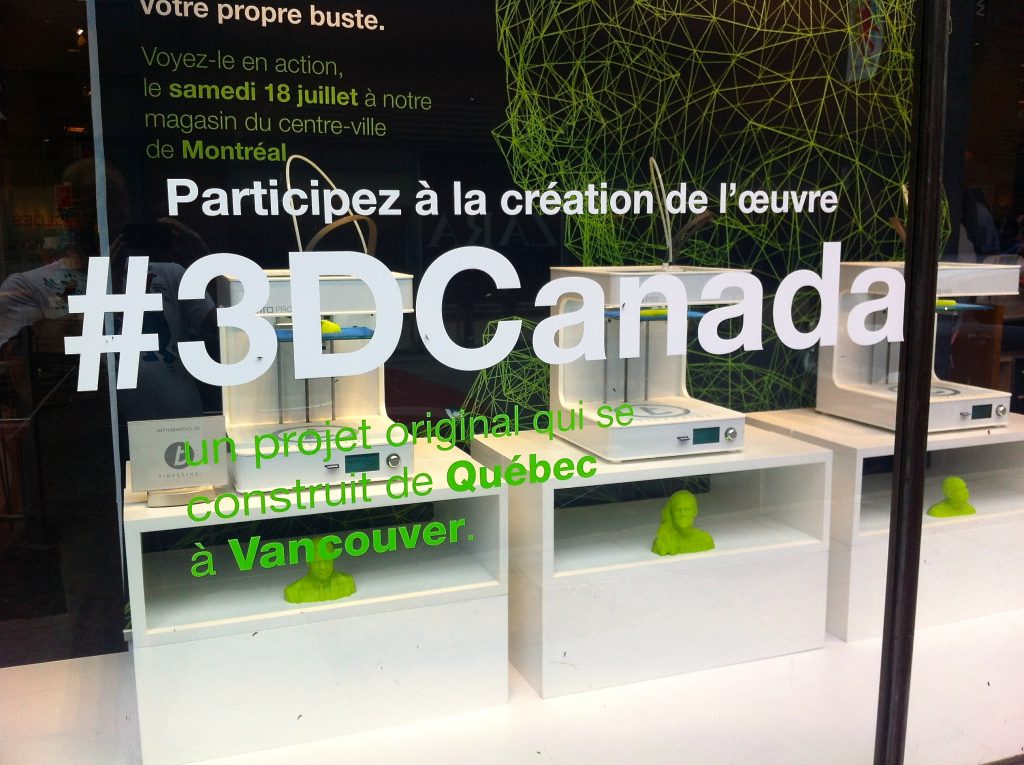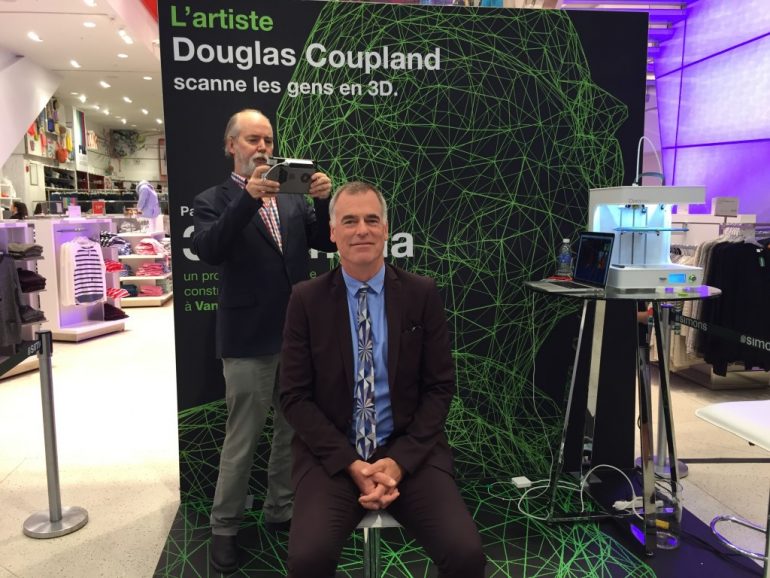In 2015, the crowd is being given even more power than before. There has been a seismic shift towards engaging and empowering the general public with technology over the past 3 to 5 years. It’s an exciting time where the ‘sharing economy’ is helping to kickstart businesses and make access to services easier. Just to the left of that sharing economy is the maker movement, where one such part is 3D printing. It has been making an impact with hobbyists for the past couple of years, and now analysts are saying that the 3D printing market is forecast to reach $20 billion by 2025 (source: IDTechEx). That will mean more printers in every business and home.
So, what is Douglas Coupland doing in the Simons’ store in Montreal scanning hundreds of Canadians to create models ready for 3D printing? The famed Canadian artist and author of such books as Generation X, JPod, and Microserfs will be running the 3D CANADA project at six Simons stores across Canada throughout 2015 and 2016 to scan, print busts and create an installation of about 1,200 Canadians for a collaborative art piece that shows a modern portrait of Canada.
I spoke to Douglas Coupland about the project, who said “it’s a very interesting moment in creative history. 3D printing feels like the 2.5 dimension to me. It’s a mirror you can go inside and look around. It’s really quite simple now and in 10 years they’ll say ‘can you believe all they did was scan heads’. This is our first stab at what a group portrait looks like in 2015.”
“When photography was introduced in the 19th century, everyone said painting is dead. Now we have 3D printing and everyone is saying sculpture is dead. The third dimension is dead.”
– Douglas Coupland
But will 3D printing be more widely adopted? Coupland provided some perspective, saying that “historically, when photography was introduced in the 19th century, everyone said painting is dead. Now we have 3D printing and everyone is saying sculpture is dead. The third dimension is dead. What happens with any new invention is whatever technology is left behind can now relax and start doing artistic things.”
Why is one of Canada’s oldest retailers (Simons is 175 years old) embracing cutting edge technology like 3D printing? Angela Stinson, Director of Store Development for Simons, elaborated a little more about the project. “Originally, Douglas was commissioned to do an art piece at our Park Royal store in Vancouver. We were talking and he had just bought a 3D printer and wanted to scan us. This led to a large conversation about manufacturing, art and 3D printing. That was 38 weeks ago and it was the beginning of planning this project.”
The 3D CANADA project started in Quebec at the Festival D’été, and will then stop in Simons’ stores in Mississauga, Ottawa, Calgary and Park Royal in West Vancouver. The printers being used are even Canadian. 13 Tinkerine DittoPro 3D printers, aka ‘the printer farm’, will be on display in the stores and will be 3D printing the scans of the customers. The customers can then pick up their replicas a couple of days later and larger versions will be produced for the final portrait. Once all the stores have been visited, Douglas will incorporate all the scanned data of the people from across Canada that we’ve scanned and we’ll build them into a large scale art piece that will tour the stores and ultimately be permanently installed in the Toronto location.
Stinson elaborated a little more about where this technology might go within Simons. “We are asking ourselves, how can we continue this in our stores? Jewelry, iPhone cases, accessories, and anything that our customers are interested in and can be added to the retail mix. We know that there is a demand for 3D printing in our stores and we are looking at how we can roll this out over the coming months. We’re open to see where it goes.”
“It’s going to change how we sell. It’s going to change everything.”

Interestingly enough, we are also seeing other well-known organizations jumping into crowdsourcing with a more practical application as well. Just last week, NASA Tournament Lab (NTL) announced that it partnered with Freelancer.com to help design a number of CAD models of tools to be used by the Robonaut 2 (robotic space assistant) on the International Space Station. A number of items including RFID Scanners, Drills, and Scopemeters are being designed via contests on the crowdsourcing platform. Hundreds of designers have entered the contests thus far.
These designs can even be sent to the International Space Station and be printed by the newly installed 3D printer that NASA had installed earlier this year. This is a more practical application that, while it feels grandiose, ties directly back into the home.
What is certain is that open access to 3D designs and the ability to print quickly and easily is proving out to not just be a fad. It will have practical applications in art, in the home, and even in space (which will be important for planned settlement on other planets). Imagine printing a commissioned piece of art, printing a collection of plates by a famous potter and distributed by a retailer, and even reimagining your home decor week-by-week.
I talked to Coupland about the potential for 3D printing to be as common as a fixture in your utility room, alongside your washer and dryer. When asked about the potential of 3D printers he added, “Washing machine, dryer, 3D printer. It’s just going to become quotidian as a toaster. If you need a part then you just find it online and print it.”
Images courtesy John Biehler.


